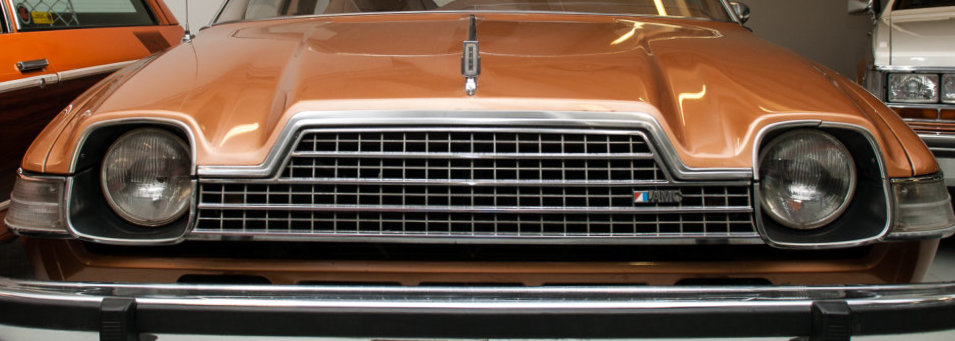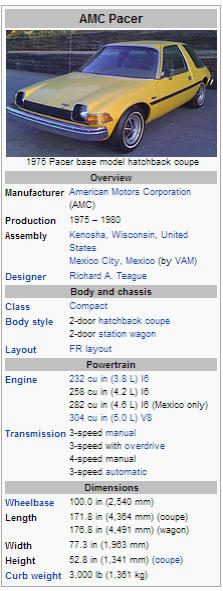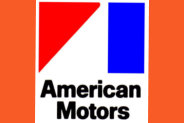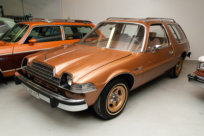



“The Flying Fishbowl”

AMC Pacer Wagon - 76
The AMC Pacer is a two-door compact automobile that
was produced in the United States by the American
Motors Corporation between 1975 and 1980.
Design work began in 1971. The rounded shape and large glass area were unusual compared with the three-box designs of the era. The Pacer's width is equal to full-sized domestic vehicles at the time, and this unique design feature was promoted by AMC as "the first wide small car." The Pacer was the first modern mass-produced, U.S. automobile design using the cab forward concept. The Pacer's rounded and aerodynamic "jellybean" styling has made it an icon of the 1970s. The May 1976 issue of Car and Driver dubbed it "The Flying Fishbowl", and it was also described as "the seventies answer to George Jetson's mode of transportation" at a time when "Detroit was still rolling out boat-sized gas guzzlers."1976
The initial VAM Pacers were the equivalents to the U.S. AMC Pacer DL models except for a noticeably longer list of standard equipment and included some features of the U.S. Limited models of 1979 and 1980. The VAM Pacer had had no model or trim level, and U.S. derivatives such as the Pacer X, the base model, and the Levis Pacer were not available. The VAM Pacer's standard engine was the gross 200 hp (149 kW; 203 PS) 282 cu in (4.6 L) I6 with 7.7:1 compression ratio, 266 degree camshaft and a Holley 2300 two-barrel carburetor coupled to a steel intake manifold, and featured a T-150 three-speed manual transmission with heavy duty clutch and a 3.31:1 rear gear ratio. All VAM Pacers came with heavy-duty suspension (front sway bar with stiff springs and shock absorbers), power brakes with front disks, power steering (rack and pinion unit), larger radiator with coolant recovery tank, rigid four-bladed cooling fan, and electronic ignition. Standard convenience features included a custom luxury steering wheel, column-mounted manual shifter, woodgrain dashboard trim, inside hood release, individual reclining front seats with adjustable headrests, center folding arm rest, fixed two-point seatbelts, two-speed electric wipers, electric washers integrated to the wiper arms, 140 km/h speedometer (some few units had a 160 km/h unit), courtesy lights, monaural AM radio with a single in-dash speaker, electric analog clock, heater with windshield defroster, lighter, dashboard ashtray, locking glove box, tinted windshield, plaint door panels (U.S. base model type without cloth insert and pull strap), dual rear ashtrays, folding down rear bench seat, trunk carpet, sound-insulating cardboard-type headliner (U.S. base model type), and round dome light. The external appearance and equipment of the VAM Pacer consisted of a full bright molding package (wheel lips, top edge of the hood and fenders, window surrounds, rocker panels), bright rear panel between the taillights and the rear licence plate housing, protective side moldings, front and rear bumper guards, bumper nerfing strips, five-mile-per-hour bumpers with recovering shocks (only VAM car with this characteristic along with the Matador-based Classic line), five-spoke in-house VAM wheels, trim rings and full cover volcano center caps on the wheels, ER78x14 radial tires, driver's side manual remote mirror, radio antenna on the passenger's side fender, and a two-step hood latch. The concept of the VAM Pacer was entirely different compared to the AMC Pacer. The car was focused to be a high-end luxury car from its introduction to its end, while American Motors counterpart started as an economy car and import fighter. This was reinforced after the first 200 units produced when the three-speed automatic transmission joined the standard equipment list. The VAM Pacer became the most costly and luxurious VAM car at the mid-year discontinuation of the 1976 Classic line. The uniqueness of the model coupled to its level of luxury and price range practically made the car a flagship for the company, even though it was never officially considered as such. Probably the most unique aspect of the 1976 VAM Pacer lies in its seat designs. VAM created a design based on AMC's Oleg Cassini interior for the 1974-1975 Matador coupe that used not just in the Pacer but in all three VAM Classic models for the year. The Pacer's seats incorporated a golden Cassini crest on the headrests and a pattern with copper buttons forming squares. Unlike the AMC Pacer, the VAM Pacer had a very short list of factory optional equipment. These included rear wiper and washer, rear defroster, reading dome light, trunk cover, remote-controlled driver's side mirror and luxury wheel covers and heavy duty cooling system (seven-bladed flexible fan and fan shroud). A universal air conditioning system was available only as a dealership option among a few others not present in the factory list.
1976
This collections Pacer has been bought new and it is still in perfect road condition.

Photos mainly by Matti Kreivilä. Historical facts and technical details of the vehicles provided by Wikipedia. Movies YouTube.


- Decade of 60's
- Austin 850 Pickup - 1962
- Chaika Tshaika 13 GAZ - 1962
- Citroen 2CV - 1961
- DKW Junior - 1961
- Fiat 1100 - 1963
- Ford Taunus 12M - 1961
- GLAS 1204 - 1963
- MG 1100 - 1964
- Moskvich 407 - 1961
- Nagetusch caravan - 1961
- NSU Printz 4 - 1961
- Opel Kadett A - 1964
- Panhard PL17 - 1961
- Peugeot 404 - 1962
- Renault Dauphine - 1965
- Simca Aronde P60 - 1960
- Simca 1000 - 1966















